Author: Nancy, PANews
In recent days, Ethereum has made a strong upward move, boosting the morale of "E Guardians" and rapidly increasing bullish sentiment in the market. This strong rally not only brings a comprehensive recovery to the Ethereum ecosystem but also heightens market expectations for the staking function of Ethereum spot ETFs, especially as related staking projects become hotspots for capital.
Ethereum's Strong Rebound, ETF Staking Expectations Boost Confidence Recovery
Recently, Ethereum has experienced several days of strong rebounds, with its total market capitalization surpassing Alibaba, ranking 39th globally in asset market value. The related surge in topics has even topped Douyin's hot list, becoming a focal point of market discussion.
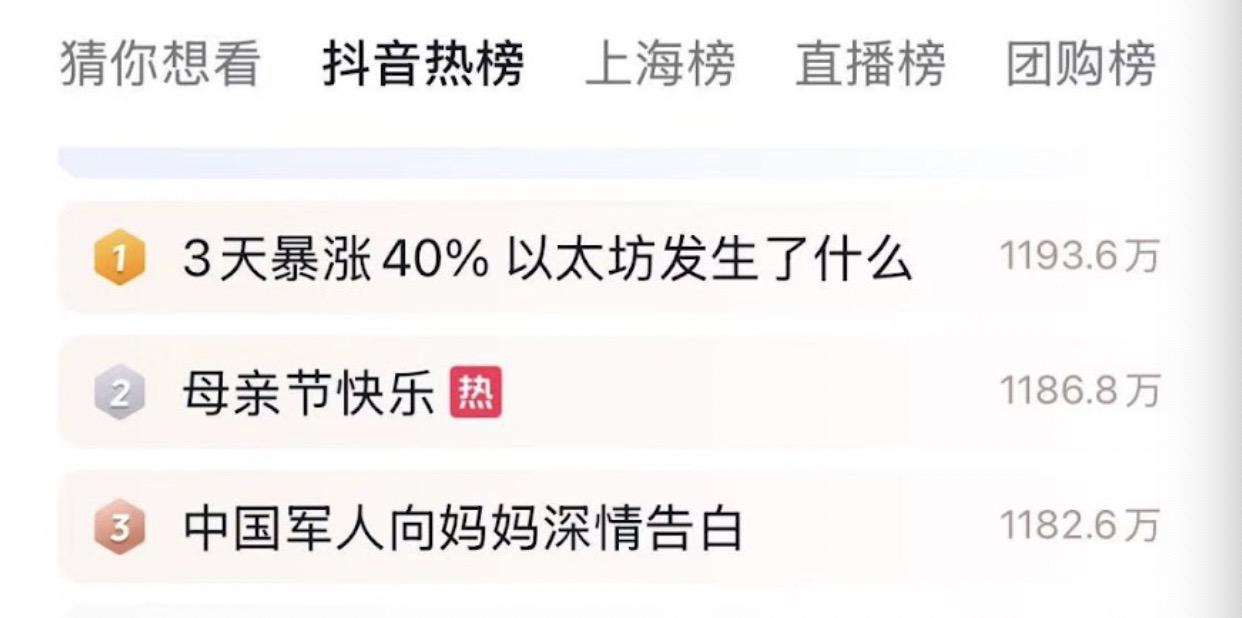
According to CoinGecko data, as of May 12, Ethereum's price rose to $2,521, reaching a nearly two-month high, with a 40.4% increase over the past week, and a weekly market cap surge of over $87.58 billion. Meanwhile, Coinglass data shows that as of the time of writing, Ethereum's monthly return rate for May has reached 39.53%, marking the strongest single-month increase since 2025, significantly surpassing the historical median increase for May (18.43%) and the average increase (31.15%). This strong rebound not only ends Ethereum's three-month downward trend but also marks a significant turning point in market sentiment, demonstrating a simultaneous recovery in capital and investment confidence.
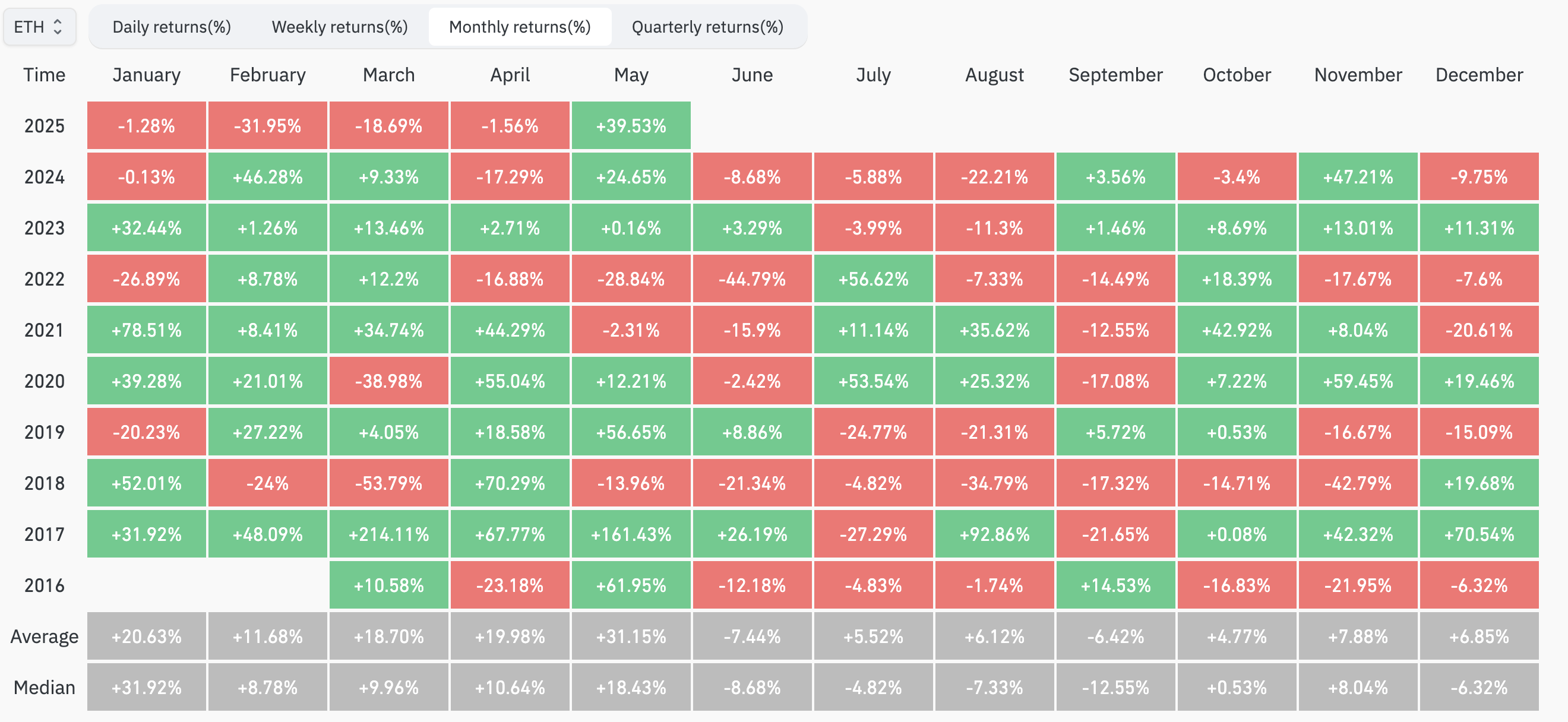
On-chain capital movements further validate this trend. Artemis data shows that over the past seven days, the Ethereum ecosystem attracted up to $1.2 billion in capital inflows, ranking first among all blockchains. The net inflow of funds exceeded $490 million, far ahead of other mainstream public chains.
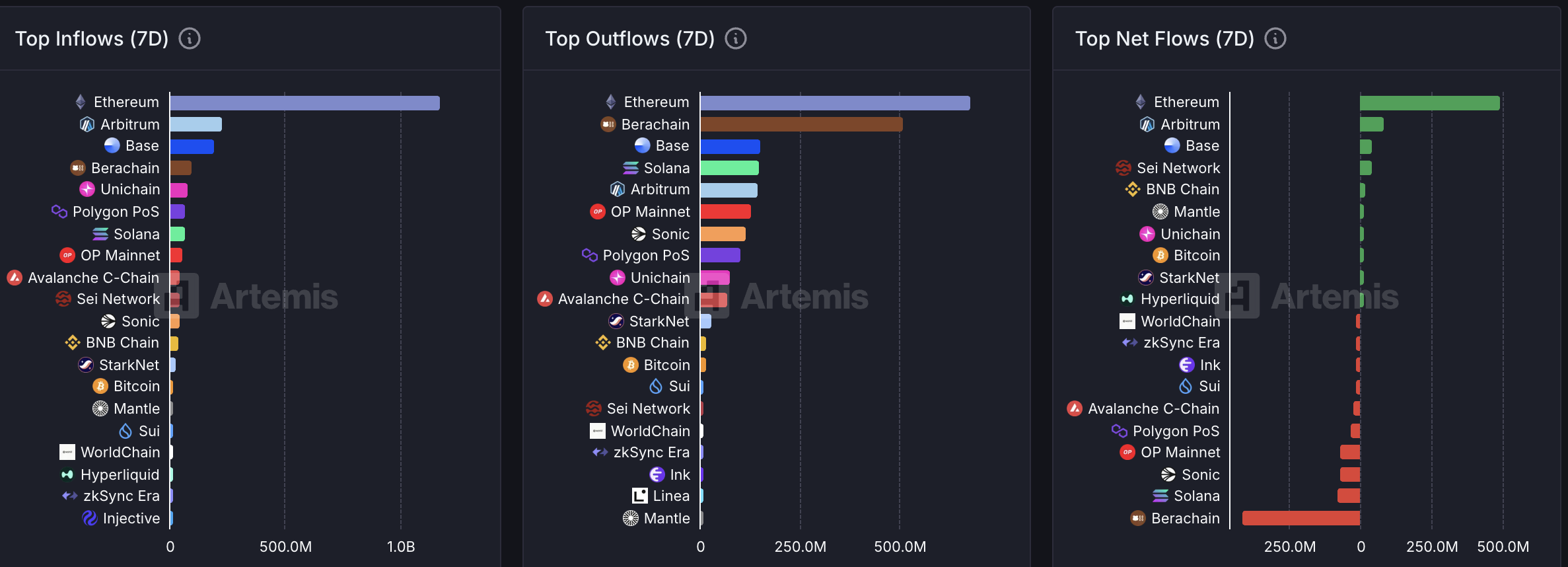
This rebound is believed to be the result of multiple factors resonating, including marginal improvements in macroeconomic policies, price corrections from previously excessive bearish sentiment, the upcoming Ethereum Pectra upgrade, the continuous expansion of real-world narratives, and positive expectations for Ethereum spot ETF staking.
Among these, the expectation for ETF staking functions has become one of the important catalysts. In recent months, several institutions have actively sought SEC approval to allow the introduction of staking mechanisms in crypto ETF products. Although the SEC has recently delayed the approval of applications from institutions like Fidelity and Grayscale, related discussions are accelerating.
At the end of April this year, Grayscale met with the SEC's crypto working group in Washington, D.C., to discuss regulatory changes regarding staking for Ethereum ETPs, stating that the total assets managed by U.S. Ethereum ETPs amount to $8.1 billion, but due to the inability to participate in staking, they have lost approximately $61 million in revenue since their launch until February 2025. The institution pointed out that introducing a staking mechanism would help enhance the security of the Ethereum network while providing additional returns for shareholders.
Another asset management giant, BlackRock, also recently met with the SEC's crypto working group, covering topics such as crypto asset regulation, ETF staking, and options products. Documents show that the meeting discussed "considerations for promoting ETPs with staking functions" and parameters for determining crypto ETF options positions and exercise limits, as well as specific standards for approving crypto ETFs. Notably, Robert Mitchnick, head of digital assets at BlackRock, stated in March that if Ethereum spot ETFs could incorporate staking functions, although there are some "complex challenges" to resolve, staking yields are an important way to achieve investment returns in this field, which could become a "transformational turning point" for Ethereum.
It is worth noting that Hong Kong regulators have taken the lead on the issue of crypto ETF staking. In April this year, the Hong Kong Securities and Futures Commission (SFC) issued new guidelines allowing licensed virtual asset trading platforms (VATPs) to provide staking services to clients, while virtual asset funds (such as Ethereum spot ETFs) can participate in on-chain staking activities under a prudent regulatory framework, subsequently approving two Ethereum spot ETF products with staking functions.
These positive developments in ETF staking have effectively boosted market expectations for Ethereum and further accelerated the confidence recovery process.
Staking Track Heats Up Significantly, Leading Projects' TVL and Token Prices Soar Together
The Ethereum staking track has also become a key focus for capital and narratives. DeFiLlama data shows that as of May 12, the TVL of the Ethereum staking track has risen to $34.11 billion, achieving a 60.3% increase over the past month. Meanwhile, the TVL of the re-staking track has also risen to nearly $12.85 billion, with a 54.8% increase over the past 30 days.
This article by PANews reviews the latest market trends and performances of five leading staking projects in the Ethereum ecosystem, which have made breakthroughs in technical progress, governance mechanisms, and ecological construction, driving overall market recovery, with both TVL and token prices achieving double-digit growth.
Lido: TVL Soars Close to $23 Billion, Driven by Technology and Governance
Lido is the largest liquid staking protocol. DeFiLlama data shows that as of May 12, Lido's TVL is approximately $22.93 billion, with a staggering increase of 57.5% over the past month. Meanwhile, Coingecko data shows that its native token LDO has also increased by about 48.6% during the same period.
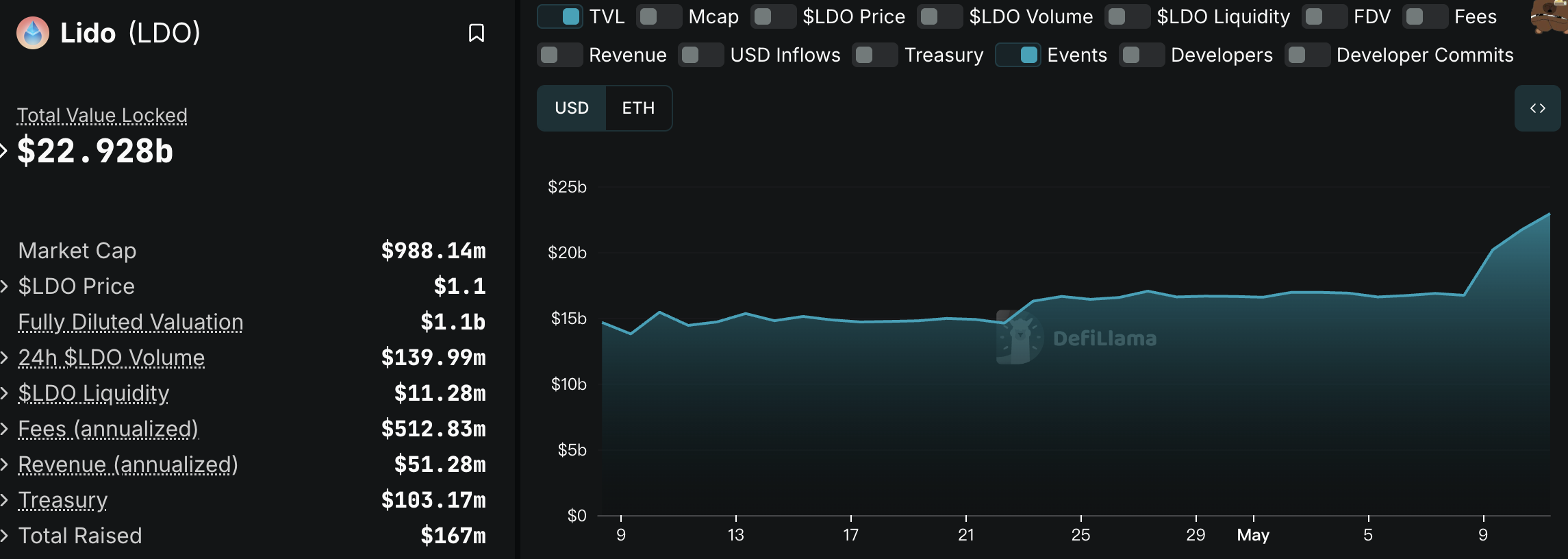
In recent months, Lido has made progress in both governance and technology. In April, Lido DAO initiated several governance votes, including Snapshot votes and Aragon main phase votes, involving protocol updates and decisions. In the same month, Lido launched the V3 testnet, allowing developers to create customized staking solutions using Lido stVaults on the Hoodi Ethereum testnet. Lido stVaults are modular primitives that allow stakers, node operators, and protocols to customize staking solutions according to their needs. Users can customize fee structures, validation settings, optimize risk/return structures, etc., while retaining the advantages of stETH. Recently, Lido announced the upcoming launch of a "dual governance" mechanism, a dynamic time-locking mechanism that allows stETH holders to exit Lido on Ethereum when facing controversial governance motions.
It is worth mentioning that despite recent concerns over a potential leak of the oracle private key from Chorus One, Lido DAO promptly initiated an emergency proposal, and staking users were not affected; the protocol remains secure and operates normally. Additionally, since Lido's oracle system employs a 9-out-of-5 multi-signature mechanism, a single oracle failure does not threaten the system, and the remaining nodes were unaffected.
EigenLayer: Multi-line Advancement Boosts Token Price and TVL Together
EigenLayer continues to hold its position as the leader in the re-staking track. DeFiLlama data shows that as of May 12, EigenLayer's TVL reached $11.36 billion, with an approximate growth of 52% over the past month. Meanwhile, Coingecko data shows that its native token EIGEN increased by 69.7% during the same period.
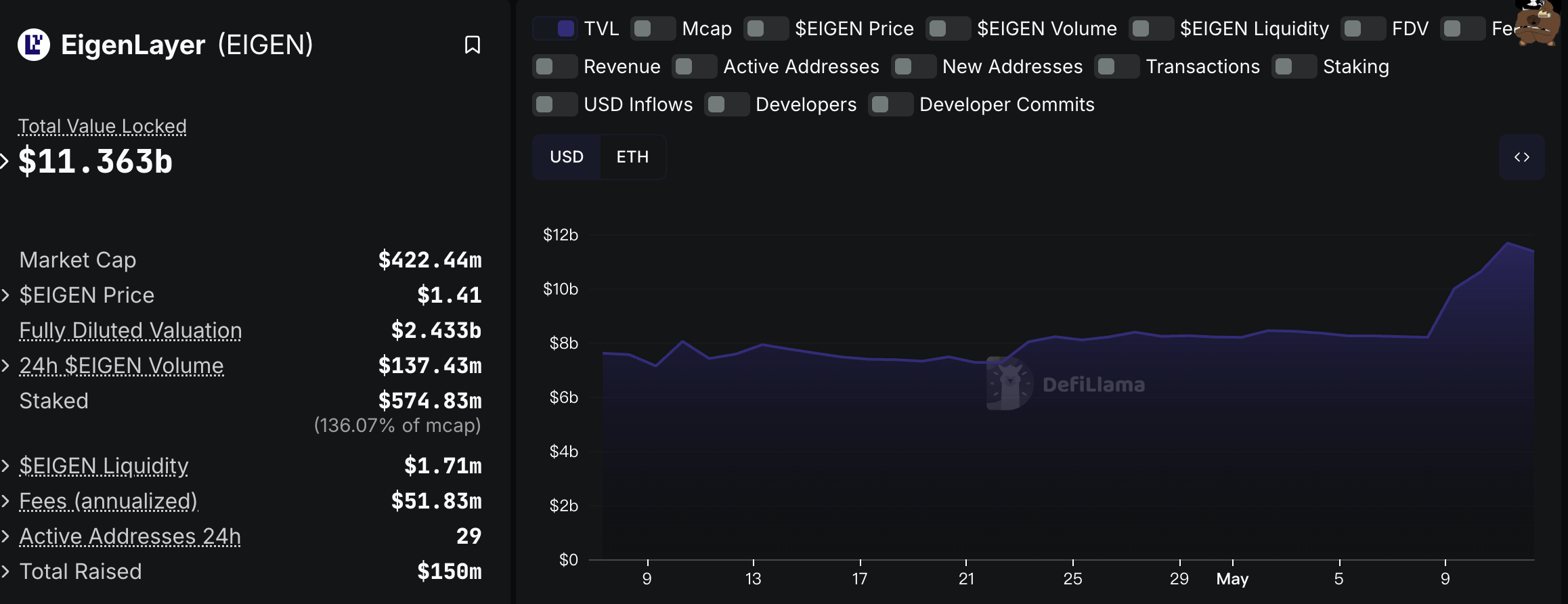
In the past two months, EigenLayer has continued to advance in technical upgrades, developer ecology, and application expansion. In mid-April, EigenLayer's Slashing (penalty mechanism) was officially launched on the mainnet, requiring operators and stakers using EigenPod CLI to perform checkpoint upgrades, while various application validation services (AVS) can now directly implement penalty conditions on the mainnet. Shortly after, EigenLayer announced the upcoming launch of the Redistribution feature, bringing new capabilities to its Slashing upgrade. This feature allows decentralized validation services (AVS) to reallocate funds after staking funds are penalized, rather than directly destroying them, thus supporting more complex use cases such as lending and insurance protocols. The first batch supports non-ETH assets (such as LSTs, EIGEN, USDC, and AVS tokens), with ETH not yet included, planned for launch on the Ethereum mainnet in June. In recent days, EigenLayer announced its participation in the Ethereum Pectra upgrade on May 7 to support improvements to the Ethereum network and plans to introduce validator integration for EigenPods, as well as announcing plans to host the "Berlin Hacker Village" in Berlin to attract global developers to build the next generation of verifiable applications.
Rocket Pool: From Node Incentives to Ecological Integration, Driving TVL and Token Prices Up Together
Rocket Pool is also a highly regarded Ethereum staking protocol. DeFiLlama data shows that Rocket Pool's TVL reached $1.74 billion, with an increase of approximately 56.3% over the past month. Meanwhile, Coingecko data shows that its native token RPL increased by about 67.5% during the same period.
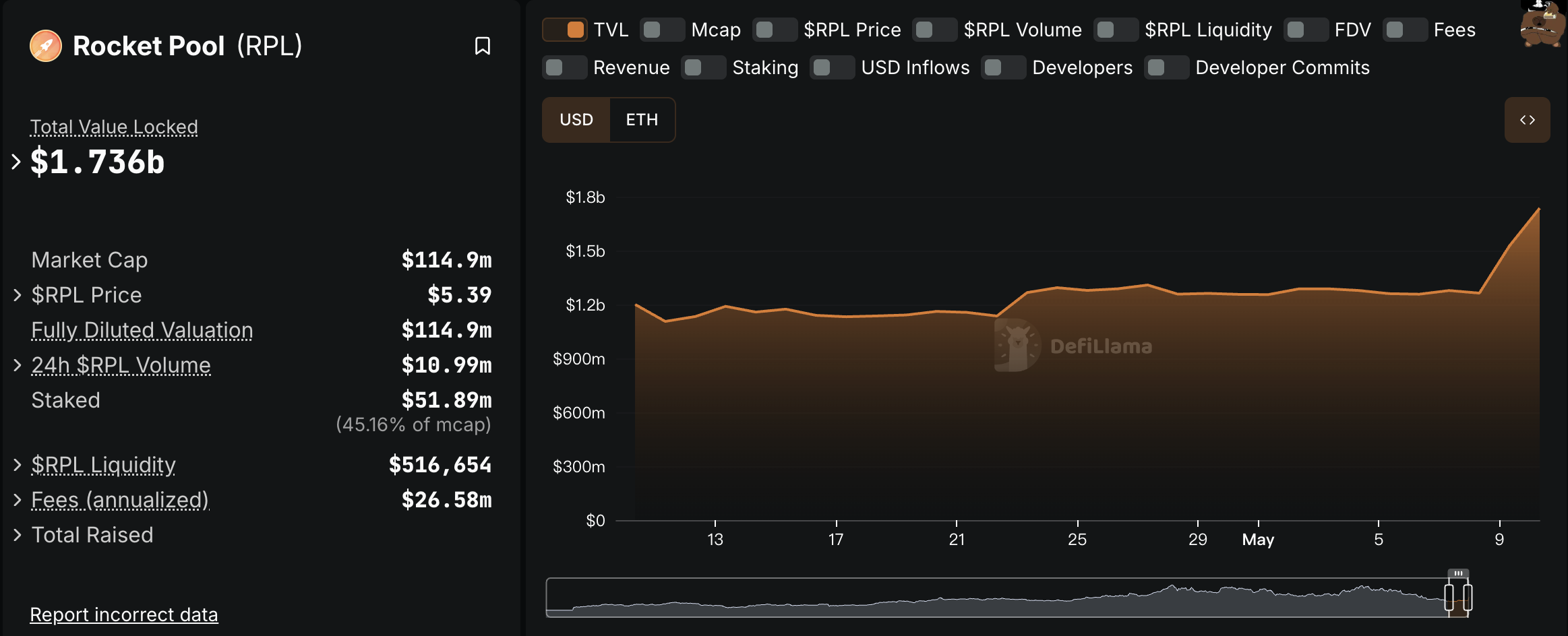
In the past two months, Rocket Pool has primarily focused on technical upgrades, community governance, and expanding the DeFi ecosystem. For example, in March, Rocket Pool announced the distribution of 133 ETH to node operators, emphasizing that the pool is free to join with no usage fees, attracting more participants; in April, Rocket Pool released a Smart Node update and held a community call to discuss whether the DAO should raise funds through bridging fees and share quarterly product development roadmap updates, as well as promote the integration of rETH in DeFi protocols; in May, Rocket Pool actively promoted node software updates to support the launch of the Pectra upgrade.
Symbiotic: TVL Surpasses $1 Billion, Secures Tens of Millions in Financing
The re-staking protocol Symbiotic primarily emphasizes modular security and capital efficiency. DeFiLlama data shows that Symbiotic's TVL has exceeded $1.09 billion, with an increase of approximately 45% over the past month.

In the past two months, Symbioticfi has continued to advance its universal re-staking protocol and has recently made positive progress in financing. In April, Symbiotic announced the completion of a $29 million Series A financing round, with participation from institutions such as Paradigm, CyberFund, Pantera Capital, and Coinbase Ventures. In the same month, ether.fi announced the launch of a $40 million crypto venture fund, with Symbiotic being one of its first investment projects.
SSV Network: Token Price Increased Over 90% in a Month, Active Validators Exceed 100,000
According to the official website, as of May 12, SSV Network's TVL has exceeded $8.9 billion, with the amount of ETH staked approaching 3.467 million. Coingecko data shows that in the past month, its token SSV has surged by 91.6%.

Recently, SSV Network announced that its active validators have surpassed 100,000, accounting for about one-tenth of Ethereum validators. This tweet received support from many partners, including Lido, Renzo, Kraken, ChainLayer, HashKey Cloud, Nansen, Swell, and Eigenpie. Additionally, on May 6, SSV Network announced the launch of the SSV 2.0 testnet on Hoodi, aiming to significantly enhance the security of the Ethereum ecosystem by introducing the concept of "application-based" (bApps), while reducing developers' security costs by up to 90% and providing risk-free returns for validators, thereby unlocking more value for the entire ecosystem.
免责声明:本文章仅代表作者个人观点,不代表本平台的立场和观点。本文章仅供信息分享,不构成对任何人的任何投资建议。用户与作者之间的任何争议,与本平台无关。如网页中刊载的文章或图片涉及侵权,请提供相关的权利证明和身份证明发送邮件到support@aicoin.com,本平台相关工作人员将会进行核查。




